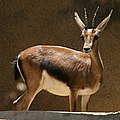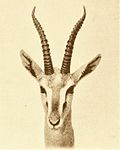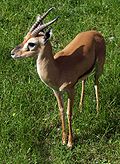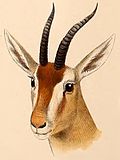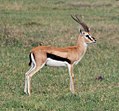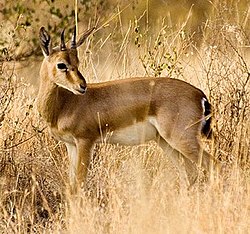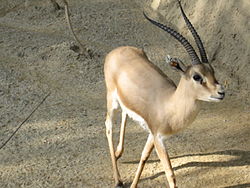| Gazella Temporal range: Miocene-Recent | |
|---|---|
 | |
| Chinkara from Thar Desert, Rajasthan, India | |
| Scientific classification | |
| Kingdom: | Animalia |
| Phylum: | Chordata |
| Class: | Mammalia |
| Order: | Artiodactyla |
| Family: | Bovidae |
| Subfamily: | Antilopinae |
| Tribe: | Antilopini |
| Genus: | Gazella Blainville, 1816 |
| Type species | |
| Capra dorcas [1] | |
| Species | |
Several, see text | |
A gazelle is one of many antelope species in the genus Gazella /ɡəˈzɛlə/ . [2] There are also seven species included in two further genera; Eudorcas and Nanger , which were formerly considered subgenera of Gazella. A third former subgenus, Procapra , includes three living species of Asian gazelles.
Contents
Gazelles are known as swift animals. Some can run at bursts as high as 100 km/h (60 mph) or run at a sustained speed of 50 km/h (30 mph). [3] Gazelles are found mostly in the deserts, grasslands, and savannas of Africa, but they are also found in southwest and central Asia and the Indian subcontinent. They tend to live in herds, and eat fine, easily digestible plants and leaves.
Gazelles are relatively small antelopes, most standing 60–110 cm (2–3.5 ft) high at the shoulder, and are generally fawn-colored.
The gazelle genera are Gazella, Eudorcas, and Nanger. The taxonomy of these genera is confused, and the classification of species and subspecies has been an unsettled issue. Currently, the genus Gazella is widely considered to contain about 10 species. [4] One species is extinct: the Queen of Sheba's gazelle. Most surviving gazelle species are considered threatened to varying degrees. Closely related to the true gazelles are the Tibetan goa, and Mongolian gazelles (species of the genus Procapra), the blackbuck of Asia, and the African springbok.
One widely familiar gazelle is the African species Thomson's gazelle (Eudorcas thomsonii), sometimes referred to as a "tommie". It is around 60 to 70 cm (24 to 28 in) in shoulder height and is coloured brown and white with a distinguishing black stripe. The males have long, often curved, horns. Like many other prey species, tommies exhibit a distinctive behaviour of stotting (running and jumping high before fleeing) when they are threatened by predators such as cheetahs, lions, African wild dogs, crocodiles, hyenas, and leopards.


